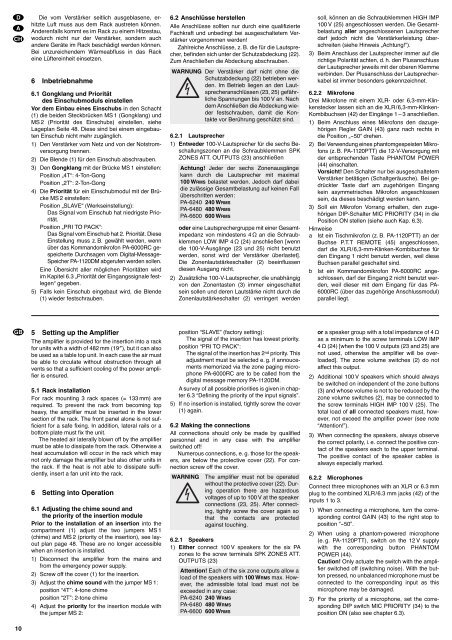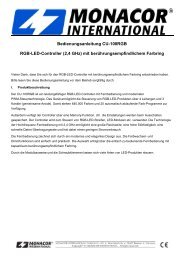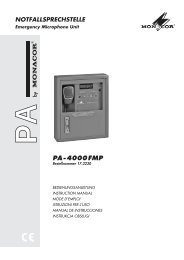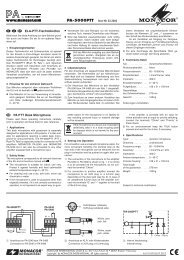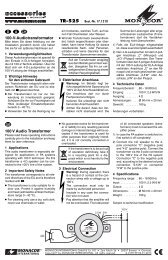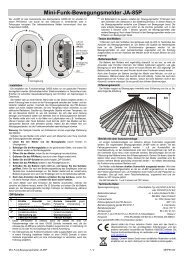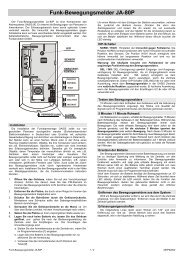Manuales de instrucciones - Monacor
Manuales de instrucciones - Monacor
Manuales de instrucciones - Monacor
Create successful ePaper yourself
Turn your PDF publications into a flip-book with our unique Google optimized e-Paper software.
D<br />
A<br />
CH<br />
GB<br />
10<br />
Die vom Verstärker seitlich ausgeblasene, er -<br />
hitzte Luft muss aus <strong>de</strong>m Rack austreten können.<br />
An<strong>de</strong>renfalls kommt es im Rack zu einem Hitzestau,<br />
wodurch nicht nur <strong>de</strong>r Verstärker, son<strong>de</strong>rn auch<br />
an<strong>de</strong>re Geräte im Rack beschädigt wer<strong>de</strong>n können.<br />
Bei unzureichen<strong>de</strong>m Wärmeabfluss in das Rack<br />
eine Lüftereinheit ein setzen.<br />
6 Inbetriebnahme<br />
6.1 Gongklang und Priorität<br />
<strong>de</strong>s Einschubmoduls einstellen<br />
Vor <strong>de</strong>m Einbau eines Einschubs in <strong>de</strong>n Schacht<br />
(1) die bei<strong>de</strong>n Steckbrücken MS 1 (Gongklang) und<br />
MS 2 (Priorität <strong>de</strong>s Einschubs) einstellen, siehe<br />
Lageplan Seite 48. Diese sind bei einem eingebauten<br />
Einschub nicht mehr zu gänglich.<br />
1) Den Verstärker vom Netz und von <strong>de</strong>r Notstromversorgung<br />
trennen.<br />
2) Die Blen<strong>de</strong> (1) für <strong>de</strong>n Einschub abschrauben.<br />
3) Den Gongklang mit <strong>de</strong>r Brücke MS 1 einstellen:<br />
Position „4T“: 4-Ton-Gong<br />
Position „2T“: 2-Ton-Gong<br />
4) Die Priorität für ein Einschubmodul mit <strong>de</strong>r Brücke<br />
MS 2 einstellen:<br />
Position „SLAVE“ (Werks einstellung):<br />
Das Signal vom Einschub hat niedrigste Priorität.<br />
Position „PRI TO PACK“:<br />
Das Signal vom Einschub hat 2. Priorität. Diese<br />
Einstellung muss z. B. gewählt wer<strong>de</strong>n, wenn<br />
über das Kommandomikrofon PA-6000RC ge -<br />
speicherte Durchsagen vom Digital-Message-<br />
Speicher PA-1120DM abgerufen wer<strong>de</strong>n sollen.<br />
Eine Übersicht aller möglichen Prioritäten wird<br />
im Kapitel 6.3 „Priorität <strong>de</strong>r Eingangssignale festlegen“<br />
gegeben.<br />
5) Falls kein Einschub eingebaut wird, die Blen<strong>de</strong><br />
(1) wie<strong>de</strong>r festschrauben.<br />
5 Setting up the Amplifier<br />
The amplifier is provi<strong>de</strong>d for the insertion into a rack<br />
for units with a width of 482 mm (19″), but it can also<br />
be used as a table top unit. In each case the air must<br />
be able to circulate without obstruction through all<br />
vents so that a sufficient cooling of the power amplifier<br />
is ensured.<br />
5.1 Rack installation<br />
For rack mounting 3 rack spaces (= 133 mm) are<br />
required. To prevent the rack from becoming top<br />
heavy, the amplifier must be inserted in the lower<br />
section of the rack. The front panel alone is not sufficient<br />
for a safe fixing. In addition, lateral rails or a<br />
bottom plate must fix the unit.<br />
The heated air laterally blown off by the amplifier<br />
must be able to dissipate from the rack. Otherwise a<br />
heat accumulation will occur in the rack which may<br />
not only damage the amplifier but also other units in<br />
the rack. If the heat is not able to dissipate sufficiently,<br />
insert a fan unit into the rack.<br />
6 Setting into Operation<br />
6.1 Adjusting the chime sound and<br />
the priority of the insertion module<br />
Prior to the installation of an insertion into the<br />
compartment (1) adjust the two jumpers MS 1<br />
(chime) and MS 2 (priority of the insertion), see layout<br />
plan page 48. These are no longer accessible<br />
when an insertion is installed.<br />
1) Disconnect the amplifier from the mains and<br />
from the emergency power supply.<br />
2) Screw off the cover (1) for the insertion.<br />
3) Adjust the chime sound with the jumper MS 1:<br />
position “4T”: 4-tone chime<br />
position “2T”: 2-tone chime<br />
4) Adjust the priority for the insertion module with<br />
the jumper MS 2:<br />
6.2 Anschlüsse herstellen<br />
Alle Anschlüsse sollten nur durch eine qualifizierte<br />
Fachkraft und unbedingt bei ausgeschaltetem Verstärker<br />
vorgenommen wer<strong>de</strong>n!<br />
Zahlreiche Anschlüsse, z. B. die für die Lautsprecher,<br />
befin<strong>de</strong>n sich unter <strong>de</strong>r Schutzab<strong>de</strong>ckung (22).<br />
Zum Anschließen die Ab<strong>de</strong>ckung abschrauben.<br />
WARNUNG Der Verstärker darf nicht ohne die<br />
Schutzab<strong>de</strong>ckung (22) betrieben wer<strong>de</strong>n.<br />
Im Betrieb liegen an <strong>de</strong>n Lautsprecheranschlüssen<br />
(23, 25) gefährliche<br />
Spannungen bis 100 V an. Nach<br />
<strong>de</strong>m Anschließen die Ab <strong>de</strong>ckung wie<strong>de</strong>r<br />
festschrauben, damit die Kontakte<br />
vor Berührung geschützt sind.<br />
6.2.1 Lautsprecher<br />
1) Entwe<strong>de</strong>r 100-V-Lautsprecher für die sechs Be -<br />
schallungszonen an die Schraubklemmen SPK<br />
ZONES ATT. OUTPUTS (23) an schließen<br />
Achtung! Je<strong>de</strong>r <strong>de</strong>r sechs Zonenausgänge<br />
kann durch die Lautsprecher mit maximal<br />
100 WRMS belastet wer<strong>de</strong>n. Jedoch darf dabei<br />
die zulässige Gesamtbelastung auf keinen Fall<br />
überschritten wer<strong>de</strong>n:<br />
PA-6240 240 WRMS<br />
PA-6480 480 WRMS<br />
PA-6600 600 WRMS<br />
o<strong>de</strong>r eine Lautsprechergruppe mit einer Gesamtimpedanz<br />
von min<strong>de</strong>stens 4 Ω an die Schraubklemmen<br />
LOW IMP 4 Ω (24) anschlie ßen [wenn<br />
die 100-V-Ausgänge (23 und 25) nicht benutzt<br />
wer<strong>de</strong>n, sonst wird <strong>de</strong>r Verstärker überlastet].<br />
Die Zonenlautstärkeschalter (2) beeinflussen<br />
diesen Ausgang nicht.<br />
2) Zusätzliche 100-V-Lautsprecher, die unabhängig<br />
von <strong>de</strong>n Zonentasten (3) immer eingeschaltet<br />
sein sollen und <strong>de</strong>ren Lautstärke nicht durch die<br />
Zonenlautstärkeschalter (2) verringert wer<strong>de</strong>n<br />
position “SLAVE” (factory setting):<br />
The signal of the insertion has lowest priority.<br />
position “PRI TO PACK”:<br />
The signal of the insertion has 2 nd priority. This<br />
adjustment must be selected e. g. if annoucements<br />
memorized via the zone paging microphone<br />
PA-6000RC are to be called from the<br />
digital message memory PA-1120DM.<br />
A survey of all possible priorities is given in chapter<br />
6.3 “Defining the priority of the input signals”.<br />
5) If no insertion is installed, tightly screw the cover<br />
(1) again.<br />
6.2 Making the connections<br />
All connections should only be ma<strong>de</strong> by qualified<br />
personnel and in any case with the amplifier<br />
switched off!<br />
Numerous connections, e. g. those for the speakers,<br />
are below the protective cover (22). For connection<br />
screw off the cover.<br />
WARNING The amplifier must not be operated<br />
without the protective cover (22). During<br />
operation there are hazardous<br />
voltages of up to 100 V at the speaker<br />
connections (23, 25). After connect -<br />
ing, tightly screw the cover again so<br />
that the contacts are protected<br />
against touching.<br />
6.2.1 Speakers<br />
1) Either connect 100 V speakers for the six PA<br />
zones to the screw terminals SPK ZONES ATT.<br />
OUTPUTS (23)<br />
Attention! Each of the six zone outputs allow a<br />
load of the speakers with 100 WRMS max. However,<br />
the admissible total load must not be<br />
excee<strong>de</strong>d in any case:<br />
PA-6240 240 WRMS<br />
PA-6480 480 WRMS<br />
PA-6600 600 WRMS<br />
soll, können an die Schraub klemmen HIGH IMP<br />
100 V (25) angeschlossen wer<strong>de</strong>n. Die Gesamtbelastung<br />
aller angeschlossenen Lautsprecher<br />
darf jedoch nicht die Verstärkerleistung überschreiten<br />
(siehe Hinweis „Achtung!“).<br />
3) Beim Anschluss <strong>de</strong>r Lautsprecher immer auf die<br />
richtige Polarität achten, d. h. <strong>de</strong>n Plusanschluss<br />
<strong>de</strong>r Lautsprecher je weils mit <strong>de</strong>r oberen Klemme<br />
verbin<strong>de</strong>n. Der Plus anschluss <strong>de</strong>r Lautsprecherkabel<br />
ist immer beson<strong>de</strong>rs gekennzeichnet.<br />
6.2.2 Mikrofone<br />
Drei Mikrofone mit einem XLR- o<strong>de</strong>r 6,3-mm-Klin -<br />
kenstecker lassen sich an die XLR/6,3-mm-Klinken-<br />
Kombibuchsen (42) <strong>de</strong>r Eingänge 1 – 3 anschließen.<br />
1) Beim Anschluss eines Mikrofons <strong>de</strong>n dazuge -<br />
hörigen Regler GAIN (43) ganz nach rechts in<br />
die Position „-50“ drehen.<br />
2) Bei Verwendung eines phantomgespeisten Mikrofons<br />
(z. B. PA-1120PTT) die 12-V-Versorgung mit<br />
<strong>de</strong>r entsprechen<strong>de</strong>n Taste PHANTOM POWER<br />
(44) einschalten.<br />
Vorsicht! Den Schalter nur bei ausgeschaltetem<br />
Verstärker betätigen (Schaltgeräusche). Bei ge -<br />
drückter Taste darf am zuge hörigen Eingang<br />
kein asym me trisches Mikrofo n an ge schlos sen<br />
sein, da dieses beschädigt wer<strong>de</strong>n kann.<br />
3) Soll ein Mikrofon Vorrang erhalten, <strong>de</strong>n zu ge -<br />
hörigen DIP-Schalter MIC PRIORITY (34) in die<br />
Position ON stellen (siehe auch Kap. 6.3).<br />
Hinweise<br />
a Ist ein Tischmikrofon (z. B. PA-1120PTT) an <strong>de</strong>r<br />
Buchse P.T.T REMOTE (45) angeschlossen,<br />
darf die XLR/6,3-mm-Klinken-Kombibuchse für<br />
<strong>de</strong>n Eingang 1 nicht benutzt wer<strong>de</strong>n, weil diese<br />
Buchsen parallel geschaltet sind.<br />
b Ist ein Kommandomikrofon PA-6000RC angeschlossen,<br />
darf <strong>de</strong>r Eingang 2 nicht benutzt wer<strong>de</strong>n,<br />
weil dieser mit <strong>de</strong>m Eingang für das PA-<br />
6000RC (über das zugehörige Anschluss modul)<br />
parallel liegt.<br />
or a speaker group with a total impedance of 4 Ω<br />
as a minimum to the screw terminals LOW IMP<br />
4 Ω (24) [when the 100 V outputs (23 and 25) are<br />
not used, otherwise the amplifier will be overloa<strong>de</strong>d].<br />
The zone volume switches (2) do not<br />
affect this output.<br />
2) Additional 100 V speakers which should always<br />
be switched on in<strong>de</strong>pen<strong>de</strong>nt of the zone buttons<br />
(3) and whose volume is not to be reduced by the<br />
zone volume switches (2), may be connected to<br />
the screw terminals HIGH IMP 100 V (25). The<br />
total load of all connected speakers must, however,<br />
not exceed the amplifier power (see note<br />
“Attention!”).<br />
3) When connecting the speakers, always observe<br />
the correct polarity, i. e. connect the positive contact<br />
of the speakers each to the upper terminal.<br />
The positive contact of the speaker cables is<br />
always especially marked.<br />
6.2.2 Microphones<br />
Connect three microphones with an XLR or 6.3 mm<br />
plug to the combined XLR/6.3 mm jacks (42) of the<br />
inputs 1 to 3.<br />
1) When connecting a microphone, turn the corresponding<br />
control GAIN (43) to the right stop to<br />
position “-50”.<br />
2) When using a phantom-powered microphone<br />
(e. g. PA-1120PTT), switch on the 12 V supply<br />
with the corresponding button PHANTOM<br />
POWER (44).<br />
Caution! Only actuate the switch with the amplifier<br />
switched off (switching noise). With the button<br />
pressed, no unbalanced microphone must be<br />
connected to the corresponding input as this<br />
microphone may be damaged.<br />
3) For the priority of a microphone, set the corresponding<br />
DIP switch MIC PRIORITY (34) to the<br />
position ON (also see chapter 6.3).


